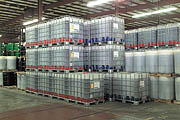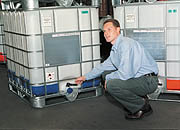Finding the Right Packaging Mix

Founded in 1970 as Huntsman Container Corp., the company pioneered such innovations as the clamshell container used for McDonald’s Big Mac™ sandwich. Riding this penchant for originality, Huntsman has become North America’s largest privately held chemical company and a petrochemical leader.
With facilities in 43 countries and annual revenues surpassing $7 billion, Huntsman is known for its polyurethanes, polymers, base chemicals, intermediate chemicals and tioxides.
When Huntsman purchased the polyurethanes business from Imperial Chemical Industries in 1999, it strengthened its specialty chemicals business with the acquisition of manufacturing sites in Wilton, UK, and Rozenburg, The Netherlands. It also acquired a share of the Rubicon Inc. joint venture facility in Geismar, LA. It was the polyurethanes facility in Geismar where Huntsman began using the Hoover Mamor.

For years, some of these products have been packaged into intermediate bulk containers (IBCs) and shipped to Huntsman customers around the world. Yet, because both parts were packaged in identical containers, production crews still had to take great care to avoid confusing these products.
Working with Hoover, Huntsman has changed its packaging system to the new European-designed, 275-gal Mamor IBC, which features the color-coding option. With the packaging change, these two-part chemicals are now shipped in color-coded IBCs. The MDI products are packaged into red Mamor containers, while polyols go into identical blue containers.
Distinct identification is important to a company that ships 12,000–14,000 IBCs annually. Before color-coded packaging, end users of the two-part polyurethane industry faced a possibility of mixing chemicals improperly during production.
With the color-coded package, that worry is gone. So are any quality concerns. “Hoover’s Mamor is as good or better than any container on the market,” said Todd Jones, Huntsman Logistics supervisor and Packaging coordinator. “It definitely is up to the same high standards of Hoover’s other IBCs and very competitively priced.
“Our customers are very pleased with the Mamor and Hoover’s Free-cycle™ program. It gives them an extra benefit that helps eliminate any production confusion and it provides our customers with total service for one price,” Jones said.
While Hoover is one of the few packaging suppliers to offer color-coded containers, that feature is not the only reason Huntsman relies on the Mamor IBC. Hoover’s willingness to wrap a range of services into the container price — including picking up empty containers at their customer sites — was also a factor.
In the Free-cycle program, Hoover picks up used containers from Huntsman’s customers regardless of where they are located — even in the isolated North Canadian woods. “Hoover proved its commitment to Free-cycle and customer service when we had a customer in a remote location in Canada, and we couldn’t get another supplier to go there. With Hoover, it was no problem whatsoever,” Jones said.
According to Jones, the Free-cycle program ensures that Huntsman’s customers dispose of the IBCs properly. “It is a customer service to both our customer and the environment. Hoover provides us with a customer brochure that explains how Free-cycle works. The customer can call Hoover, fax in a request or go on the Internet to request a pick-up,” Jones said.
In place for just a few months, Huntsman’s Mamor program is currently limited to North America, though Jones expects the company to extend the program worldwide.
Huntsman views Hoover’s program as a prime example of the chemical industry’s Responsible Care® effort. “Today, about 70% of our customers use Free-cycle, and the numbers are growing. For our customers, it is a use- it-and-forget-it program. Hoover takes care of the rest,” Jones said.
As a result, Huntsman has found Hoover to be equally dedicated to providing quality containers and excellent customer service. “With Hoover,” Jones said, “if you need a tote they will get you one no matter what.” That is important to Huntsman because in the grownup world of chemical manufacturing, quality containers and reliable customer service is just the right mix.
For more information on containers, contact Hoover Materials Handling Group Inc., 2001 Westside Parkway, Suite 155, Alpharetta, GA 30004; phone 770/664.4047; fax 770/664.2850; visit www.hooveribcs.com.
Looking for a reprint of this article?
From high-res PDFs to custom plaques, order your copy today!




